Drug Intelligence Brief
THAILAND: COUNTRY BRIEF
August 2001
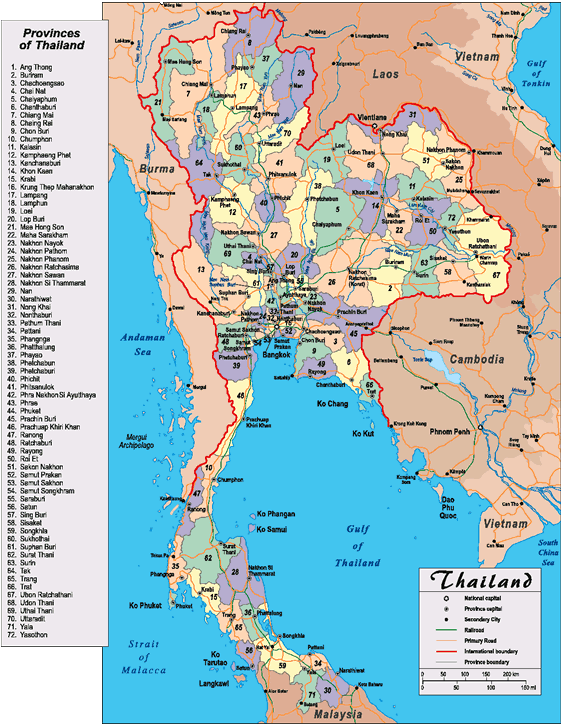
Status in International
Drug Trafficking
Thailand’s role
as the primary conduit for Southeast Asian (SEA) heroin produced in Burma
has lessened in recent years as Thai drug law enforcement capabilities
have become more sophisticated and effective. This has forced traffickers
to seek alternate routes. More heroin is now shipped through China, Cambodia,
and Laos. However, Thailand remains a primary center of operations for
heroin traffickers. The country’s modern communications and transportation
systems facilitate arrangements for drug transactions.
The opium poppy is
cultivated in Thailand largely for domestic consumption, but opiate production
does not meet local demand so raw opium is also imported from Burma and
Laos. Cannabis cultivation also takes place, but most of the marijuana
produced is shipped to foreign markets. Some methamphetamine production
takes place in Thailand, but most of the methamphetamine consumed originates
in Burma. Methamphetamine use has increased to such a degree during the
past few years that the Thai Government considers it a threat to national
security.
Cultivation and Processing
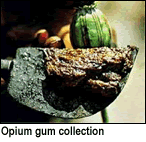 Opium Opium
Hill-tribe
farmers in northern Thailand have cultivated opium poppies for hundreds
of years for medicinal and cultural purposes. To escape detection, poppies
are often intermingled with other crops. The growing season traditionally
begins in late August or early September and some planting is done as
late as October. Since planting is staggered, harvesting can last from
November until March. The principal opium poppy-growing areas are the
Provinces of Chiang Mai (the largest area of cultivation), Chiang Rai,
Mae Hong Son, and Nan. Lesser amounts are grown in adjacent northern provinces.
Dispersed fields, often found on steep mountain slopes above 3,000 feet,
have decreased in size in recent years due to eradication efforts and
alternative crop programs initiated in the 1980s.
In 2000, opium production
in Thailand reached an estimated 4.47 metric tons, a decrease of 25.5
percent from the 6 metric tons of the previous year. A typical opium poppy
field in Southeast Asia has 250,000 poppy plants per hectare, with a range
of between 300,000 and 500,000 opium-producing pods. The opium yield from
a single pod varies greatly, ranging from 10 to 100 milligrams of opium
gum per pod. The average yield of raw opium gum per pod is approximately
80 milligrams. The dried opium yield ranges from 8 to 20 kilograms per
hectare. Land used for opium poppy cultivation totaled 398 hectares. In
an effort to avoid total eradication of their opium poppies, several years
ago, some farmers began planting a second opium poppy crop—now five
or six crop cycles are not uncommon. The poppy cultivation season has
lengthened from 3 to 8 months.
Heroin
Heroin refining activity
in Thailand was minimal in the early 1990s. A resurgence in refining activity
in 1996 and 1997 resulted from the January 1996 surrender of the Shan
United Army (SUA), then Burma’s dominant heroin trafficking organization,
to the Burma Army (BA). The SUA’s well-organized drug trafficking
activities ground to a halt and the BA and the United Wa State Army (UWSA)
occupied territory previously held by the SUA. This forced SUA remnants
still engaged in drug trafficking to relocate their refineries. New refineries,
with reduced production capacities, were established in neighboring Thai
territory.
Cannabis
In the 1970s and
1980s, Thailand ranked as Southeast Asia’s major cultivator of cannabis
and producer of marijuana in the form of “Thai sticks.” Successful
eradication campaigns forced Thai marijuana traffickers to relocate cultivation
from northeastern Thailand to neighboring Laos. Some cultivation, however,
still occurs in the northeastern region as well as the northern and southern
regions of Thailand.
Cannabis cultivation
in the Northeast is concentrated in the Provinces of Nakhon Phanom, Mukdahan,
and Sakhon Nakhon. The primary region of commercial cultivation lies in
the Tachana and Pato Districts of Chumporn Province and in the Sichom
District of Nakornsithamarat Province. Growers plant cannabis usually
among banana trees and chili shrubs to avoid detection. A hectare (6.23
rai) yields about 3,115 plants. It is estimated that Thailand produced
107 metric tons of marijuana in 1999.
Methamphetamine
Most of the methamphetamine
feeding Thailand’s growing abuse problem comes from laboratories
controlled by the UWSA, the largest opiate and methamphetamine trafficking
organization in all of Southeast Asia. However, production also occurs
in 18 Thai provinces. Most of the chemicals used to produce methamphetamine
comes from China. The precursor ephedrine is readily available in the
Chinese city of Kunming in Yunnan Province, which borders Burma. It is
transported from Kunming either by truck via Keng Tung, Burma, or by boat
along the Mekong River to northern Thailand.
Some trafficking
organizations in northern Thailand, using either rotary tableting machines
or single-punch machines, can produce large quantities of tablets per
hour. Small-scale producers may make only about 1,000 tablets a day. According
to one source, these traffickers often buy tablets from major producers,
crush the tablets, use additives, and then make new tablets with different
logos. They then sell these low-quality tablets to poorer people.
According to Thai
authorities, the tablets called “amphetamine” in Thailand are,
in fact, methamphetamine hydrochloride (HCl) mixed with caffeine, a binder,
and a coloring agent. The amount of methamphetamine HCl in each tablet
is between 20 and 30 percent. Another form of methamphetamine, powdered
crystal methamphetamine, aka “Ice,” is produced mainly in China
and North Korea.
Trafficking
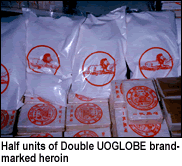 Heroin Heroin
Major international
SEA heroin trafficking groups are dominated by ethnic Chinese who reside
in Thailand, as well as throughout Southeastern Asia. They handle the
essential trafficking functions such as financing, transportation, concealment,
and contacts with heroin suppliers, foreign buyers, and money launderers.
Contacts with American, African, European, and other foreign buyers are
handled in metropolitan areas, especially in Bangkok. Ethnic Thais are
generally found in the lower or middle echelons of major international
trafficking syndicates.
The major syndicates
have long-established contacts in Burma with representatives of armed
ethnic trafficking organizations (such as the UWSA), which produce the
heroin. Contacts are also maintained with the northern Thailand-based
remnants of Chiang Kai-shek’s Third and Fifth Chinese Irregular Forces,
still significant trafficking groups, but now primarily functioning as
brokers in large drug transactions. Members of hill tribes, such as the
Akha, Lisu, and Lahu, native to the northern borders of both Thailand
and Burma, often serve as cross-border transporters and distribution agents
for these syndicates.
Small-scale suppliers
serve the domestic demand for heroin. They are predominantly ethnic Thais,
who do not have access to international trafficking networks. Many of
the SEA international traffickers have residences and businesses in Thailand.
Other international traffickers utilize Bangkok and Thailand’s beach
resorts as a central location for meetings, negotiations, and the laundering
of proceeds of drug transactions. Ethnic Chinese traffickers residing
in Thailand and other SEA countries dominate the major drug trafficking
groups. High-level Chinese traffickers in Southeast Asia, and in the United
States and Canada, prefer to deal primarily with other ethnic Chinese.
This Chinese-to-Chinese interaction is a form of insulation from some
aspects of law enforcement.
Cannabis
Because of successful
eradication efforts by the Thai Government, most marijuana is now produced
in the neighboring countries of Laos or Cambodia. Thai traffickers, however,
finance these operations.
Methamphetamine
Many of the same
international SEA heroin trafficking groups also traffic in methamphetamine.
Many of the laboratories where methamphetamine tablets are produced are
co-located with heroin refineries. Many of these methamphetamine laboratories
are either operated by, or under the control of, the UWSA. It is estimated
that the UWSA provides up to 80 percent of the methamphetamine tablets
consumed in Thailand. It is further estimated that as many as 50 methamphetamine
laboratories located in Burma will produce from 600 to 700 million tablets
for the Thai market in 2001. Government sources estimate that 600 million
tablets were smuggled into Thailand during 2000. Between January and August
2000, authorities seized 4,752 kilograms of methamphetamine tablets.
The market for this
substance is lucrative and production costs are low. Trafficking organizations
realize greater profits from selling methamphetamine than from the sale
of heroin. Also, chemical precursors are readily available and production
of methamphetamine is less complicated than producing SEA heroin #4.
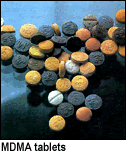 MDMA/Ecstasy MDMA/Ecstasy
Most of the Ecstasy
found in Thailand comes from the Netherlands, currently the world’s
primary producer. Wealthy young Thais, who frequent night clubs and “rave”
parties, are the primary users of Ecstasy. Ecstasy-related seizures and
cases increased from 4,520 tablets and 99 cases in 1998, to 22,000 tablets
and 175 cases in 1999. In the first 8 months of 2000, two cases resulted
in the seizure of 25,000 tablets.
Intelligence gained
as a result of several arrests in Bangkok, reflects that a Singaporean
drug trafficking group is smuggling heroin from Bangkok to Singapore,
Hong Kong, Taipei, and Europe, then returning to Southeast Asia with Ecstasy
purchased in Amsterdam. One route for this heroin is from Bangkok to Frankfurt,
Germany, via Singapore. The ultimate destination of the heroin was Amsterdam.
With the proceeds from the sale of heroin, Ecstasy is purchased in Amsterdam
and smuggled back to Southeast Asia for sale on the Asian market.
Cocaine
Prior to 1996, cocaine
importation and trafficking were rare occurrences, and while still not
a major problem, cocaine availability has increased; this is evidenced
by the more frequent cocaine seizures taking place in Thailand and other
countries in Southeast Asia. Use is largely confined to wealthy Thai nationals,
resident aliens, and tourists.
The first known cocaine
seizure occurred in March 1991, when Royal Thai Customs found 8.5 kilograms
on a cargo ship sailing from Barranquilla, Colombia. There were no indications
that the drug was intended for import or sale in Thailand. In July 1993,
the first seizure of cocaine, intended for domestic consumption, took
place at Bangkok’s international airport. Two Thai nationals were
apprehended trying to smuggle about a kilogram of the substance that they
had obtained in Los Angeles, California. In southern Thailand, in late
December 1994, a British national was arrested for attempting to distribute
about 600 grams.
Current investigations
in Thailand reflect that a group of traffickers are involved in the distribution
of cocaine and Ecstasy in Bangkok and are also smuggling cocaine and Ecstasy
to Australia.
Four couriers associated
with a Nigerian drug trafficking group were arrested and a total of 12.24
kilograms of cocaine were seized (between January 24 and April 22, 2001).
The courier flights originated in Peru, the arrests took place in Argentina,
and the couriers’ destination was ultimately Bangkok via Kuala Lumpur,
Malaysia.
In general, cocaine
seizures in Southeast Asia, especially Australia, have increased in the
last few years.
West African Heroin Traffickers
The West African
international drug traffickers who reside in Southeast Asia and specifically
in Thailand should not be classified as an organization, but are in fact
a number of groups that traffic in drugs from Southeast and Southwest
Asia to drug trafficking markets throughout the world, especially to the
United States and Canada. No one West African organization has been shown
to be the dominant or lead trafficking group in the world, and no hierarchy
or command structure has been identified with regards to West African
traffickers.
The most prominent
and active group of non-Asians buying heroin in Thailand in recent years
has been West Africans, particularly Nigerians. Usual purchases amount
to no more than 1 or 2 kilograms. During the past decade, they have used
a variety of smuggling methods, including couriers, containerized cargo,
and express mail services. West Africans, especially the Nigerians, rely
heavily on couriers to smuggle drugs throughout the world.
Due to shortages
of heroin in the Bangkok area in mid-1996 and the resulting high prices,
some of Bangkok’s Nigerian traffickers bought Southwest Asian (SWA)
heroin in Pakistan for about US$6,000 per kilogram and smuggled it to
Thailand. (Heroin obtained in Pakistan originates in Afghanistan, the
world’s largest opium producer.) Some was sold to other Nigerian
traffickers as SEA heroin. Reportedly, small quantities of SWA heroin
could be bought on the streets of Bangkok. There were a few known incidents
of SWA heroin trafficking in Thailand in 1997, and none in 1998. In 1999,
and throughout 2000, however, West African traffickers began to send couriers
to Pakistan again to buy cheaper heroin. In Bangkok, a kilogram of SWA
heroin sells for between US$10,000 and US$12,000. The same quantity of
SWA heroin can be purchased in Pakistan for between US$3,500 and US$5,000.
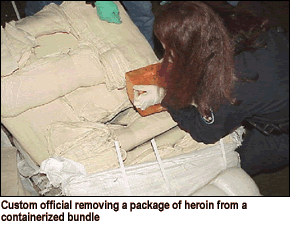 Authorities
at Bangkok’s international airport have arrested a number of couriers
who were in possession of SWA heroin. The couriers’ nationalities
included Nepalese, Swazi, Uzbek (ethnic Russian women), and Pakistani.
In several post-arrest interviews of the couriers, several admitted that
they were in the employ of West African traffickers. There have been instances
where couriers smuggled heroin to Europe, and the proceeds were used to
purchase Ecstasy. The Ecstasy was then smuggled back to Thailand. These
groups have also smuggled heroin from Asia and traded for cocaine that
is eventually smuggled back to Thailand. Authorities
at Bangkok’s international airport have arrested a number of couriers
who were in possession of SWA heroin. The couriers’ nationalities
included Nepalese, Swazi, Uzbek (ethnic Russian women), and Pakistani.
In several post-arrest interviews of the couriers, several admitted that
they were in the employ of West African traffickers. There have been instances
where couriers smuggled heroin to Europe, and the proceeds were used to
purchase Ecstasy. The Ecstasy was then smuggled back to Thailand. These
groups have also smuggled heroin from Asia and traded for cocaine that
is eventually smuggled back to Thailand.
According to Thai
law enforcement officials, most of the Ecstasy being smuggled into Thailand
is by the same groups or organizations that are smuggling heroin to Europe.
Containerized Cargo
SEA drug traffickers,
many of whom are located in the Golden Triangle (Burma, Laos, and Thailand),
specifically Thailand, form limited partnerships for the purpose of executing
specific drug transactions. Many times, these limited partnerships utilize
containerized cargo to smuggle large quantities of drugs within Southeast
Asia, and to drug markets throughout the world. Drugs are transported
from source countries to transshipment countries and then to drug markets
around the world.
Drug-Related Money Laundering
SEA traffickers avoid
the commercial banking system, when laundering their drug-related proceeds,
by using the Chinese Underground Banking System (CUBS). This relatively
unregulated, organized banking system (based upon family and business
associations) makes tracing a specific monetary transaction difficult
because minimal records are maintained. Instead, the CUBS system relies
on the trust that exists in these largely familial organizations. In essence,
the underground banker is given money and the name and phone number of
the receiver in Southeast Asia. The sender is given a receipt, which has
no legal authority, but serves only as a reminder that CUBS has the sender’s
money. Once the money is transferred from a drug-consuming country to
Southeast Asia, the receipt is presented and the money is retrieved, minus
a nominal fee. Profits are used to buy real estate, commercial property,
apartments, and stores.
Since the 1991 passage
of asset seizure legislation and its implementation in 1992, 1,003 cases
involving over US$22 million in assets have been brought to court.
Thailand passed money
laundering legislation covering seven predicate offenses, including drug
violations, in March 2000. Implementing regulations became effective in
September 2000, and reporting requirements for all financial transactions
of more than 50 million baht (US$1,250,000) began on October 27, 2000.
On February 26, 2001,
Thai counterdrug officials seized approximately 30,700,000 baht (US$767,500)
from a money launderer in Bangkok. This subject laundered money for an
individual, who had ties to members of the UWSA, and who was smuggling
heroin to Thailand and to the international market. The money was transferred
from banks in Bangkok to gold shops in Burma and ultimately to individual
accounts in banks located in Burma.
Drug Abuse and Treatment
Methamphetamine,
the most commonly abused drug, for many years was confined to those who
worked long hours, such as taxi and truck drivers. Methamphetamine is
now widely available and its use has spread throughout all segments of
society.
Unlike cocaine and
MDMA, methamphetamine is relatively inexpensive. Cocaine and Ecstasy are
abused by a small percentage of wealthy young Thai nationals, resident
aliens, and tourists who can afford the more expensive stimulants.
A U.S. Government-sponsored
study by the Thailand Development Research Institute, published in 1995,
estimated that 1.27 million people, or 2.2 percent of the total population,
were addicted to drugs of all types. This figure rose to 2 million by
2000. Other drugs used included inhalants (paint thinner and/or glue)
and marijuana. Heroin users numbered 200,000, with Bangkok having the
highest concentration. Opium users, mostly members of the northern hill
tribes, number 110,000. Drug abuse treatment efforts include inpatient
and outpatient detoxification, therapeutic communities, religion-based
rehabilitation institutions, and self-help efforts. Prevention materials
are integrated into the educational curriculum by the Ministry of Education,
and many agencies work to inform the public about the dangers of drug
abuse.
Drug Enforcement Agencies
and Legislation
The Office of the
Narcotics Control Board (ONCB), the Police Narcotics Suppression Bureau,
and the Royal Thai Army’s Third Region Command, which covers north
Thailand, are primarily responsible for the implementation of national
level drug enforcement programs. These agencies coordinate with local
police and enforcement bodies such as the Border Patrol Police, Provincial
Police, and the Royal Thai Customs Service.
U.S. assistance to
Thailand under the crop control project began in 1978 and helped Thailand’s
newly organized ONCB establish a crop control division. However, before
the crop control project was initiated, the United States and other international
donors provided substantial developmental aid for programs to assist hill-tribe
farmers in the cultivation of viable alternative crops and the infrastructure
to get those crops to market. After these economic alternatives were established
in most areas, the Royal Thai Government initiated the opium eradication
campaign in 1984.
Eradication teams
allowed long-time opium addicts to cultivate small plots for personal
use and provided emergency assistance to growers whose sole means of income
was the sale of opium. As the opium eradication program became more comprehensive,
opium fields became smaller and widely dispersed, often in very remote
and difficult-to-reach mountainous areas.
Treaties and Conventions
Thailand is a party
to the 1961 Single Convention on Narcotic Drugs, the 1972 Protocol to
the Single Convention, and the 1971 Convention on Psychotropic Substances.
An extradition treaty with the United States became effective in May 1991.
Legislation was passed in 1992 for a Mutual Legal Assistance Treaty, and
instruments of ratification were exchanged in 1993.
Thailand controls
precursor chemicals as required by the 1988 United Nations Drug Convention
and also complies with this treaty regarding money laundering legislation.
Thailand has been
extremely cooperative with the United States under the bilateral extradition
treaty. Since 1991, the government has extradited more than 50 criminals/fugitives
to the United States; more than 43 of whom were wanted for drug trafficking.
Included in this number are 13 who were arrested as a result of a very
successful 1994 joint DEA–Royal Thai Police effort, Operation TIGER
TRAP. This operation targeted trafficking members of the SUA in Burma
who were responsible for shipping multiton quantities of heroin to the
United States.
Thailand is a signatory
to the United Nations Drug Control Program Memorandum of Understanding
on Sub-Regional Narcotics Cooperation. The other participants are Burma,
Cambodia, China, Laos, and Vietnam. Thailand is also a member of the United
Nations Commission on Narcotic Drugs, and is ASEAN’s (Association
of Southeast Asian Nations) law enforcement coordinator for the Senior
Officials on Drugs group.
Significant Seizures - 2001
- On January 7,
2001, DEA Songkhla and DEA Bangkok, in conjunction with Thai counterdrug
officials, interdicted a fishing vessel and seized 116 kilograms of
heroin and 10 drums containing 7,700,000 methamphetamine tablets.
- On January 11,
2001, Thai counterdrug officials seized 1 million methamphetamine tablets
from a vehicle, which had crossed over into Mae Sai, Thailand, from
Tachilek, Burma.
Significant Seizures - 2000
- An investigation
conducted in September and October by Thai counterdrug officials in
Bangkok resulted in the seizure of 1,948,000 methamphetamine tablets.
- On October 6,
2000, Thai counterdrug officials seized 2,550,000 methamphetamine tablets.
- On October 10,
2000, Thai counterdrug officials seized 2,000,000 methamphetamine tablets
in Bangkok.
Outlook
- Despite successful
law enforcement efforts, Thailand remains a primary center for SEA heroin
trafficking operations. Thailand is also used as a transit area for
SWA heroin.
- Bangkok will continue
to serve as a center for large-scale drug transactions by individuals
representing major trafficking groups from the United States, Canada,
Taiwan, Hong Kong, Australia, Nigeria, and Europe.
- Thailand-based
ethnic Chinese handle all essential trafficking functions and continue
to dominate major international heroin trafficking groups. Ethnic Thais
are generally found in the lower to middle echelons of the major trafficking
organizations.
- Thailand continues
to be successful in eradication efforts and drug enforcement legislation.
Statistics and Enforcement
Actions (1996 - 2000)
|
1996
|
1997
|
1998
|
1999
|
2000
|
| Opium |
| Potential
Harvest (hectares) |
2,170
|
1,650
|
1,350
|
835
|
890
|
| Eradication
(hectares) |
880
|
1,050
|
715
|
808
|
757
|
| Cultivation
(hectares) |
3,050
|
2,700
|
2,065
|
1,643
|
1,647
|
| Potential
Yield (metric tons) |
30
|
25
|
16
|
6
|
6
|
| Potential
Heroin (metric tons) |
2
1/2
|
2
|
1
1/3
|
1/2
|
1/2
|
|
|
| Cannabis
|
| Potential
Harvest (metric tons) |
0
|
0
|
0
|
107
|
-
|
| Eradication
(hectares) |
85
|
0
|
0
|
0
|
-
|
|
| Seizures |
| Opium
(metric tons) |
0.630
|
0.440
|
1.500
|
0.720
|
0.620
|
| Heroin
(metric tons) |
0.290
|
0.310
|
0.530
|
0.320
|
0.390
|
| Cannabis
(metric tons) |
6.50
|
45.25
|
6.00
|
9.00
|
44.00
|
| Ecstasy
(tablets) |
0
|
0
|
4,520
|
22,000
|
0
|
|
| Other
Data |
| Heroin
Laboratories Destroyed |
2
|
3
|
1
|
0
|
0
|
| Meth
Laboratories Destroyed |
1
|
19
|
13
|
14
|
9
|
| Drug
Arrests (thousands) |
125
|
158
|
186
|
205
|
133
|
|
| Other
Data |
| Opium
Consumed (metric tons) |
60.0
|
60.0
|
60.0
|
60.0
|
60.0
|
| Heroin
Consumed (metric tons) |
4.0
|
4.0
|
4.0
|
4.0
|
4.0
|
| Opium
Users (thousands) |
111
|
111
|
111
|
111
|
111
|
| Heroin
Users (thousands) |
220
|
220
|
220
|
220
|
220
|
| Methamphetamine
Users (millions) |
|
|
|
|
2.7
|
Drug Prices for 2001 (in
US Dollars)
| Opium |
| Northern
Thailand |
$312.00
- $625.00 per kilogram |
| Northeastern
Thailand |
$500.00/Raw
$875.00/Processed |
| Southern
Thailand |
$150.00
- $250.00 |
| Bangkok |
No
Prices |
|
| Heroin
82% - 92+% purity price |
| Chiang
Mai |
$7,500
per unit |
| Bangkok |
$8,000
- $11,000 (700 grams) |
| Songkhla |
$9,500
per kilogram |
| Chiang
Mai (northern Thailand) |
$7,857
- $10,357 |
| Songkhla
(southern Thailand) |
$10,715
- $14,285 |
| Udorn
(northeastern Thailand) |
$9,125
- $10,750 |
| Bangkok |
$10,000
- $13,000 |
|
| Cannabis
per kilogram |
| Bangkok |
$125.00
- $138.00 |
| Northeastern
Thailand |
$47.00
- $58.00 |
|
| Methamphetamine
22% - 28% purity price per tablet |
| Thai/Burma
border |
$.75
- $1.75 |
| Bangkok |
$1.00
- $1.88 |
| Southern
Thailand |
$2.50
- $4.00 |
| Northeastern
Thailand |
$.83
- $1.13 |
|
| Cocaine
per gram (retail) |
| Bangkok |
$88.00 |
|
| Ecstasy
price per tablet |
| Bangkok |
$15.00
- $30.00 |
| Southern
Thailand |
$25.00
- $37.50 |
|
|
Note:
Prices converted from Thai baht to US dollars - 40 Baht = US$1
|
| This
report was prepared by the Europe, Asia, Africa Strategic Unit (NIBE)
of the Office of International Intelligence. This report reflects
information through February, 2001. Comments and requests for copies
are welcome and may be directed to the Intelligence Production Unit,
Intelligence Division, DEA Headquarters, at (202) 307-8726. |
DEA-01025
|

